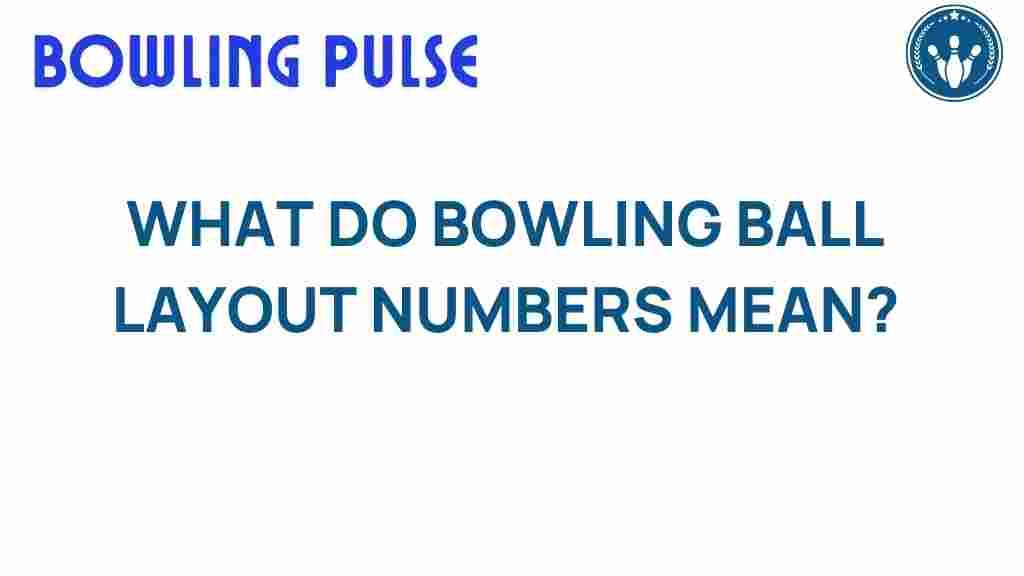Unraveling the Mystery: What Bowling Ball Layout Numbers Reveal
Bowling is a sport that combines skill, precision, and strategy. Understanding the intricacies of bowling ball layout is crucial for optimizing your performance on the lanes. In this article, we will explore the significance of bowling ball layout numbers, how they relate to various bowling techniques, and the impact they have on your overall bowling performance. We’ll also provide valuable tips and insights into lane dynamics and strike optimization, ensuring you have all the tools you need to elevate your game.
What is Bowling Ball Layout?
The term bowling ball layout refers to the specific configuration of a bowling ball’s drilling pattern. This layout dictates how the weight is distributed within the ball, ultimately influencing its reaction on the lane. The layout is typically represented by a series of numbers that indicate the position of the finger and thumb holes, as well as the overall balance of the ball.
When you understand what these numbers mean, you can make informed decisions about your bowling ball setup, which can significantly enhance your game.
Understanding Bowling Ball Layout Numbers
Bowling ball layouts are often expressed in a numerical format, usually comprising three key numbers:
- Pin Distance: This number indicates the distance from the pin (the small dot on the ball) to the center of the finger holes.
- Mass Bias Location: This number shows where the mass bias is located in relation to the thumb hole.
- Drilling Angle: This angle affects how the ball will roll and hook on the lanes.
Each of these components plays a vital role in how the ball interacts with the lane, so understanding them can help you choose the right bowling ball layout for your style.
The Science Behind Bowling Ball Layouts
The principles of bowling science dictate that the layout affects the ball’s performance based on various factors, including lane conditions, oil patterns, and bowler technique. By analyzing these elements, bowlers can fine-tune their equipment to optimize their chances of striking.
- Bowling Techniques: Different layouts can enhance certain techniques, such as hook or straight shots.
- Lane Dynamics: Understanding how oil patterns affect ball reaction can help bowlers choose the right layout.
- Strike Optimization: A well-chosen layout can lead to more strikes by maximizing the ball’s potential to hit the pins effectively.
Choosing the Right Bowling Ball Layout
When selecting a bowling ball layout, consider the following steps:
- Assess Your Style: Determine if you are a straight bowler, a hook bowler, or somewhere in between. Your style will influence the ideal layout.
- Consult with an Expert: A pro shop technician can provide insights based on your performance and preferences.
- Test Different Layouts: Experiment with various layouts to see how they affect your game. Keep track of your scores and adjustments.
Common Bowling Ball Layout Options
Here are some popular bowling ball layouts and their typical applications:
- Label Layout: Ideal for straight shots and minimal hook. Great for beginners.
- Strong Layout: Increases the ball’s hooking potential, making it suitable for bowlers with a high rev rate.
- Balanced Layout: Offers versatility, allowing bowlers to adjust their technique based on lane conditions.
Troubleshooting Your Bowling Ball Layout
If you’re experiencing issues with your bowling performance, consider the following troubleshooting tips:
- Inconsistent Ball Reaction: This may indicate that your layout is not suited for the current lane conditions. Consult with a technician to explore adjustments.
- Struggling to Hook the Ball: If you’re unable to achieve the desired hook, consider a layout that emphasizes weight on the finger holes.
- Frequent Split Hits: This could signal that your mass bias is misaligned. Adjusting the drilling angle may help.
Bowling Tips for Performance Improvement
Improving your bowling performance is not solely about the right layout; it also involves refining your skills and techniques. Here are some essential bowling tips to enhance your game:
- Focus on Your Approach: A consistent approach sets the foundation for a successful delivery. Practice your footwork to build muscle memory.
- Improve Your Release: Work on your timing and wrist position during release to increase accuracy and hook potential.
- Analyze Lane Conditions: Take note of how the oil pattern affects your ball’s movement and adjust your layout accordingly.
The Importance of Equipment in Bowling
Proper equipment plays a significant role in your bowling performance. When considering your bowling ball layout, ensure that you’re using the right gear:
- Bowling Ball Selection: Choose a ball that complements your layout and playing style.
- Shoes: Invest in quality bowling shoes that provide the necessary support and traction.
- Accessories: Consider using wrist supports or finger grips to aid in your delivery and comfort.
Conclusion: Mastering Bowling Ball Layout for Optimal Performance
Understanding bowling ball layout numbers is essential for any bowler looking to enhance their game. By grasping the science behind layouts, experimenting with different configurations, and applying effective bowling techniques, you’ll be well on your way to optimizing your performance.
Remember, the right equipment combined with your skills can lead to improved scores and a better overall bowling experience. For more tips and insights into bowling, check out this resource that delves deeper into the world of bowling science.
Whether you’re a novice or an experienced bowler, always seek to learn and adapt. With the right knowledge and practice, you’ll be able to unravel the mysteries of bowling ball layouts and take your game to the next level.
If you’re looking for expert advice on bowling ball layouts and performance optimization, consider visiting your local bowling pro shop or check out this bowling community for additional insights and tips.
This article is in the category Techniques and created by BowlingPulse Team
